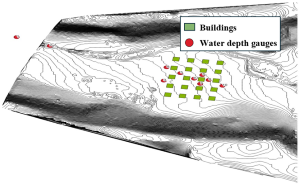Comparison of FLUMEN and HEC-RAS 2D Models for Flash Flood Inundation in Urban Landscape
DOI:
https://doi.org/10.46604/peti.2024.13794Keywords:
flash flood, FLUMEN, HEC-RAS 2D, numerical modelAbstract
Flood inundation maps play a crucial role in preventing flood damage. Among various numerical models used to generate these maps, the fluvial modeling engine (FLUMEN) and the hydrologic engineering center’s river analysis system (HEC-RAS 2D) are particularly effective for simulating urban floods, which are influenced by complex factors such as buildings and landscapes. This study aims to examine the differences in flood analysis results that may arise from using different numerical models. This study compares the performance of FLUMEN and HEC-RAS 2D in modeling urban flash floods, characterized by local velocity variations and complex geometries. The analysis focuses on their numerical characteristics and simulation accuracy. The simulation results show that HEC-RAS 2D outperforms FLUMEN in handling turbulence, numerical stability, and peak water level predictions. These findings provide insights into the strengths and limitations of each model for urban flood management.
References
R. B. Mudashiru, N. Sabtu, I. Abustan, and W. Balogun, “Flood Hazard Mapping Methods: A Review,” Journal of Hydrology, vol. 603, Part A, article no. 126846, December 2021.
Han River Flood Control Office, “River Flood Map,” https://floodmap.go.kr/, April 1, 2024
P. Luo, M. Luo, F. Li, X. Qi, A. Huo, Z. Wang, Y. Wang, et al., “Urban Flood Numerical Simulation: Research, Methods, and Future Perspectives,” Environmental Modelling & Software, vol. 156, article no. 105478, October 2022.
Z. Liu, V. Merwade, and K. Jafarzadegan, “Investigating the Role of Model Structure and Surface Roughness in Generating Flood Inundation Extents Using One- and Two-Dimensional Hydraulic Models,” Journal of Flood Risk Management, vol. 12, no. 1, pp. 1-19, March 2019.
I. Shustikova, A. Domeneghetti, J. C. Neal, P. Bates, and A. Castellarin, “Comparing 2D Capabilities of HEC-RAS and LISFLOOD-FP on Complex Topography,” Hydrological Sciences Journal, vol. 64, no.14, pp. 1769-1782, 2019.
T. Willis, N. Wright, and A. Sleigh, “Systematic Analysis of Uncertainty in 2D Flood Inundation Models,” Environmental Modelling & Software, vol. 122, article no. 104520, December 2019.
M. S. Horritt and P. D. Bates, “Evaluation of 1D and 2D Numerical Models for Predicting River Flood Inundation,” Journal of Hydrology, vol. 268, no. 1-4, pp. 87-99, November 2002.
C. H. Lee and T. G. Lee, “Evaluation of an Applicability of HEC-RAS 5.0 for 2-D Flood Inundation Analysis,” Journal of the Korea Academia-Industrial Cooperation Society, vol. 17, no.4, pp. 726-733, April 2016. (In Korean)
B. Lavoie and T. F. Mahdi, “Comparison of Two-Dimensional Flood Propagation Models: SRH-2D and Hydro_AS-2D,” Natural Hazards, vol. 86, pp. 1207-1222, 2004.
K. Vashist and K. K. Singh, “HEC-RAS 2D Modeling for Flood Inundation Mapping: a Case Study of the Krishna River Basin,” Water Practice & Technology, vol. 18, no. 4, pp. 831-844, April 2023.
J. H. Park and K. Y. Han, “Applicability Analysis of 2-D Model for Evacuation Map to Establish Dam Emergency Action Plan,” Journal of The Korean Society of Hazard Mitigation, vol. 20, no. 2, pp. 47-59, April 2020.
A. Ferrari, R. Vacondio, and P. Mignosa, “High-Resolution 2D Shallow Water Modelling of Dam Failure Floods for Emergency Action Plans,” Journal of Hydrology, vol. 618, article no. 129192, March 2023.
Z. Naiji, O. Mostafa, N. Amarjouf, and H. Rezqi, “Application of Two-Dimensional Hydraulic Modelling in Flood Risk Mapping: A Case of the Urban Area of Zaio, Morocco,” Geocarto International, vol. 36. no. 2, pp. 180-196, 2021.
P. Dimas, G. Pouliasis, P. Dimitriadis, P. Papanicolaou, S. Lazaridou, and S. Michas, “Comparison of Mudflow Simulation Models in an Ephemeral Mountainous Stream in Western Greece Using HEC-RAS and FLO-2D,” Euro-Mediterranean Journal for Environmental Integration, vol. 8, no.4, pp. 919-933, December 2023.
G. Testa, D. Zuccala, F. Alcrudo, J. Mulet, and S. Soares-Frazão, “Flash Flood Flow Experiment in a Simplified Urban District,” Journal of Hydraulic Research, vol.45, no. 1, pp. 37-44, 2007.
User’s Guide: FLUMEN, Vers. 1.0, Fluvial.ch, 2003.
P. L. Roe, “Approximate Riemann Solvers, Parameter Vectors, and Difference Schemes,” Journal of Computational Physics, vol. 135, no. 2, pp. 250-258, August 1997.
P. Glaister, “An approximate Linearised Riemann Solver for the Euler Equations for Real Gases,” Journal of Computational Physics, vol. 74, no. 2, pp. 382-408, February 1988.
B. V. Leer, J. L. Thomas, P. L. Roe, and R. W. Newsome, “A Comparison of Numerical Flux Formulas for the Euler and Navier-Stokes Equations,” 8th Computational Fluid Dynamics Conference, pp. 87-1104, June 1987.
User’s Guide: HEC-RAS River Analysis System, Vers. 5.0, US Army Corps of Engineers Hydrologic Engineering Center (HEC), 2016.
R. J. LeVeque, Finite Volume Methods for Hyperbolic Problems, Cambridgeshire: Cambridge University Press, 2002.
A. Y. J. Akossou and R. Palm, “Impact of Data Structure on the Estimators R-Square and Adjusted R-Square in Linear Regression,” International Journal of Mathematics and Computation, vol. 20, no. 3, pp. 84-93, 2013.

Published
How to Cite
Issue
Section
License
Copyright (c) 2024 Chanjin Jeong, Sun-Dong Chegal, Dong-Hyun Kim, Seung-Oh Lee

This work is licensed under a Creative Commons Attribution-NonCommercial 4.0 International License.
Submission of a manuscript implies: that the work described has not been published before that it is not under consideration for publication elsewhere; that if and when the manuscript is accepted for publication. Authors can retain copyright of their article with no restrictions. Also, author can post the final, peer-reviewed manuscript version (postprint) to any repository or website.

Since Oct. 01, 2015, PETI will publish new articles with Creative Commons Attribution Non-Commercial License, under The Creative Commons Attribution Non-Commercial 4.0 International (CC BY-NC 4.0) License.
The Creative Commons Attribution Non-Commercial (CC-BY-NC) License permits use, distribution and reproduction in any medium, provided the original work is properly cited and is not used for commercial purposes







